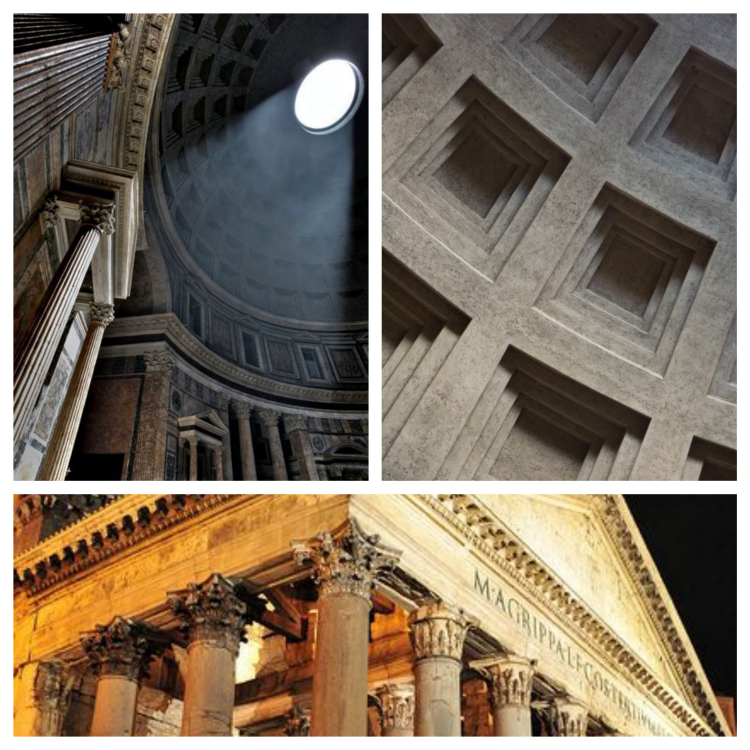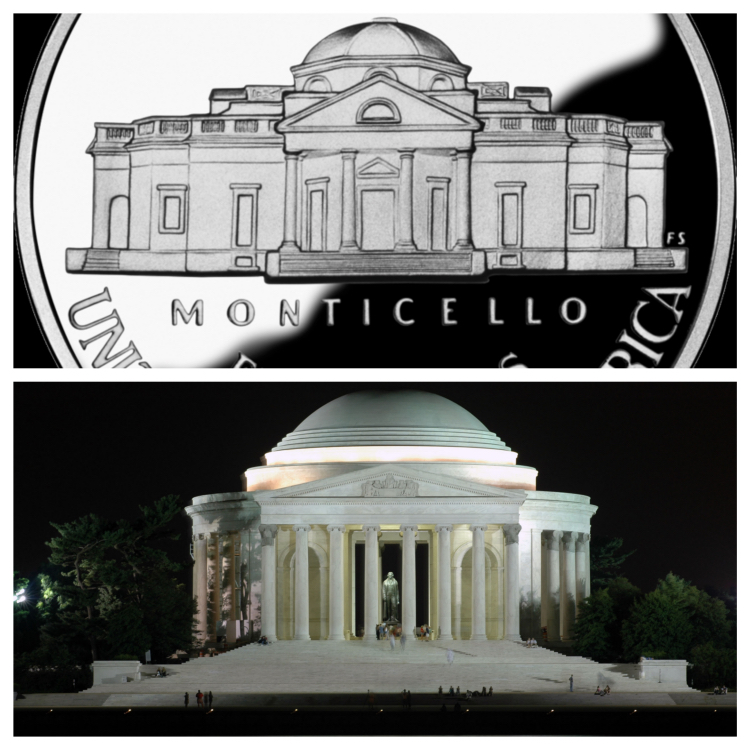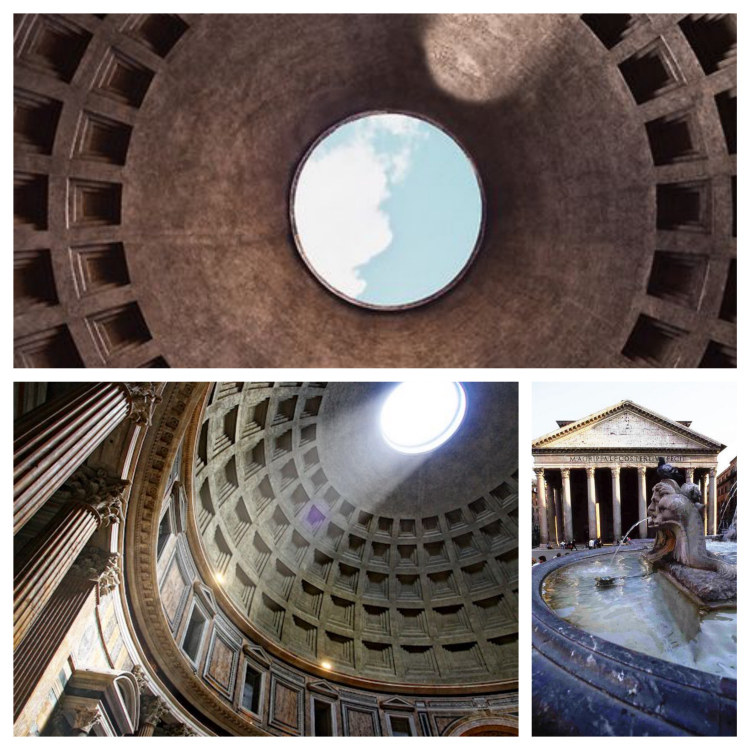
Roma. Il Pantheon
C’è un luogo che non manco mai di visitare quando mi trovo a Roma: Il Pantheon.
Il Pantheon è imponente ed ha ispirato gli architetti di tutte le epoche per la sua struttura, per la tecnica di costruzione e forse anche perché è l’unico monumento architettonico dell’antica Roma che si è conservato integro.

Dall’alto: dettaglio della moneta americana da 5 cent e il Jefferson Memorial. In entrambi i casi gli edifici rappresentati si ispirano e quasi riproducono il Pantheon di Roma.
La fortuna del Pantheon
Il Pantheon ha affascinato molti artisti e non gli è rimasto indifferente un architetto rinascimentale come Andrea Palladio, che ha sempre preso spunto dallo stile classico per adattarlo allo stile di vita del suo tempo e che nella sua Rotonda a Vicenza si è proprio ispirato alla struttura e alla cupola del Pantheon.
Molte sono le chiese, le biblioteche e gli edifici che in tutto il mondo ricordano la magnificenza di questo edificio e sarebbe impossibile elencarle tutte, ma sicuramente è curioso come alcuni dei più importanti edifici degli Stati Uniti d’America riproducano la struttura del Pantheon grazie allo stretto legame tra Palladio e Thomas Jefferson, che ha permesso di costruire il Nuovo Mondo.
Ecco perché quando abbiamo tra le mani una moneta da 5 cent americana oppure vediamo la biblioteca dell’Università della Virginia e il Jefferson Memorial osserviamo edifici che a noi sembrano familiari!
Storia e descrizione del Pantheon
Sulla facciata del Pantheon si legge “M. Agrippa L. F. Cos. tertium fecit” e ci ricorda che questo edificio fu fondato nel 27 a.C. da Agrippa. In realtà però quello che ammiriamo oggi è la ricostruzione dell’edificio fatta eseguire dall’imperatore Adriano tra il 120 e il 124 d.C., poiché alcuni incendi ne avevano danneggiato la struttura.
Il motivo principale per cui il Pantheon si è conservato intatto fino ai nostri giorni è dovuto al suo cambio d’uso.
Nel 609 d.C. Bonifacio IV trasformò il tempio in una chiesa cristiana (fu il primo caso di un tempio pagano diventato d’uso cristiano) dedicandola a “Santa Maria dei Martiri” (chiamata anche “Santa Maria della Rotonda”) e collocando al suo interno molti corpi di martiri cristiani.
L’edificio resta tuttora una chiesa in cui si celebrano regolarmente le funzioni religiose dai Canonici del Capitolo del Pantheon.
Il portico è composto da 16 colonne di granito e nel timpano era collocato un bassorilievo in bronzo con la rappresentazione della Battaglia degli Dei e dei Giganti, che è stato rimosso nel Seicento da Urbano VIII e concesso a Bernini per fonderlo e realizzare il Baldacchino di San Pietro e altre opere.
Le porte in bronzo sono, invece, originali.
La particolarità del Pantheon, e che conferisce agli interni un aspetto solenne e grandioso, è data dalla cupola e dal suo “occhio” che fa entrare la luce e l’aria.
La sua cupola è il modello di tutte le cupole costruite nei secoli successivi in Europa e nel mondo, sia nelle chiese cristiane che nelle moschee musulmane.
La cupola del Pantheon è un’opera architettonica di dimensioni eccezionali (del diametro di 43,44 m) realizzata con una tecnica di costruzione basata sull’utilizzo di cassettoni e sull’uso di materiali sempre più leggeri mano a mano che si procede verso l’alto.
Il materiale di base è il calcestruzzo ma nella parte più bassa è mischiato con scaglie di mattoni, salendo è associato a scaglie di tufo e nella parte superiore è mescolato con lapilli vulcanici.
A partire dal Quattrocento il Pantheon venne arricchito da affreschi e tra questi il più famoso è l’Annunciazione di Melozzo da Forlì (si trova nella prima cappella a destra vicino all’entrata), ma è anche il luogo dove sono stati sepolti alcuni dei più importanti artisti.
Questo è un altro dei motivi che mi portano al Pantheon ogni volta che mi trovo a Roma, perché qui riposano Raffaello Sanzio (accanto alla sua promessa sposa che morì tre mesi prima di lui) ed Annibale Carracci e dell’architetto Baldassarre Peruzzi.
In questo edificio si trovano inoltre le tombe di Vittorio Emanuele II di Savoia (primo Re d’Italia), del Re Umberto I di Savoia e della Regina Margherita.

Alcune curiosità sul Pantheon
- La Cupola e il Suo Oculo: La cupola del Pantheon è ancora oggi la più grande cupola in calcestruzzo non armato del mondo. Al centro, trovi un oculo aperto di 8,8 metri di diametro. Questo non solo serve a illuminare l’interno del tempio, ma ha anche una funzione simbolica: rappresenta il sole e la sua luce, un collegamento diretto tra il tempio e il cielo.
- Il Mistero del Cemento Romano: Gli ingegneri moderni sono ancora affascinati dalla tecnologia utilizzata per costruire il Pantheon. Il calcestruzzo utilizzato per la cupola è leggero e resistente, una combinazione che gli ingegneri di oggi cercano ancora di replicare.
- Un Tempio Dedicato a Tutti gli Dei: Il nome “Pantheon” significa “tempio di tutti gli dei”. Originariamente, il Pantheon era dedicato al culto di tutti gli dei del pantheon romano. Con il passare dei secoli, è stato trasformato in una chiesa cristiana, ma il suo nome originale rimane un chiaro indizio della sua funzione iniziale.
- L’Acqua Piovana e l’Oculo: Una domanda comune è: cosa succede quando piove? Sorprendentemente, la pioggia che entra dall’oculo raramente bagna il pavimento, grazie a un sistema di drenaggio ben progettato e alla velocità del vento che spesso devia la pioggia.
- Il Pantheon come Fonte di Ispirazione: L’architettura del Pantheon ha ispirato numerosi edifici in tutto il mondo, tra cui il Jefferson Memorial a Washington D.C. e il Palazzo della Civiltà Italiana a Roma.
Queste curiosità sul Pantheon aggiungono ulteriore meraviglia e ammirazione per questo monumento senza tempo. È un simbolo della grandezza di Roma e del genio architettonico che ha superato i secoli, continuando a ispirare e affascinare.
Quando visiterai il Pantheon (attenzione ora è necessario prenotare i biglietti per visitare il Pantheon), ricorda questi dettagli e immagina le innumerevoli storie che ha vissuto e testimoniato nel corso della sua lunga esistenza.
[en:]
Roma and the Pantheon
There is one place I never fail to visit when I am in Rome: the Pantheon.
The Pantheon is imposing and has inspired architects of all ages because of its structure, construction technique and perhaps also because it is the only architectural monument of ancient Rome that has been preserved intact.

Dall’alto: dettaglio della moneta americana da 5 cent e il Jefferson Memorial. In entrambi i casi gli edifici rappresentati si ispirano e quasi riproducono il Pantheon di Roma.
The fortune of the Pantheon
The Pantheon has fascinated many artists and a Renaissance architect like Andrea Palladio, who always took inspiration from the classical style to adapt it to the lifestyle of his time, was not indifferent to it. In his Rotonda in Vicenza, he was precisely inspired by the structure and dome of the Pantheon.
There are many churches, libraries and buildings all over the world that recall the magnificence of this building and it would be impossible to list them all, but it is certainly curious how some of the most important buildings in the United States of America reproduce the structure of the Pantheon thanks to the close ties between Palladio and Thomas Jefferson, who allowed the construction of the New World.
That is why when we hold an American 5 cent coin in our hands or see the University of Virginia library and the Jefferson Memorial we see buildings that look familiar to us!
History and description of the Pantheon
The Pantheon’s façade reads ‘M. Agrippa L. F. Cos. tertium fecit’ and reminds us that this building was founded in 27 BC by Agrippa. In reality, however, what we admire today is the reconstruction of the building commissioned by Emperor Hadrian between 120 and 124 AD, as some fires had damaged the structure.
The main reason why the Pantheon has remained intact to this day is due to its change of use.
In 609 AD. Boniface IV transformed the temple into a Christian church (it was the first case of a pagan temple becoming Christian in use) dedicating it to ‘St Mary of the Martyrs’ (also called ‘St Mary of the Round’) and placing many bodies of Christian martyrs inside.
The building still remains a church in which religious services are regularly celebrated by the Canons of the Pantheon Chapter.
The portico is composed of 16 granite columns and in the tympanum was placed a bronze bas-relief depicting the Battle of the Gods and Giants, which was removed in the 17th century by Urban VIII and given to Bernini to cast and make the Baldachin of St. Peter and other works.
The bronze doors, however, are original.
The Pantheon’s special feature, which gives the interior a solemn and grandiose appearance, is its dome and its ‘eye’ that lets in light and air.
Its dome is the model for all domes built in later centuries in Europe and the world, both in Christian churches and Muslim mosques.
The Pantheon’s dome is an exceptionally large architectural work (43.44 m in diameter) built using a construction technique based on the use of caissons and the use of lighter and lighter materials as one moves upwards.
The basic material is concrete, but in the lower part it is mixed with brick flakes, going upwards it is associated with tuff flakes and in the upper part it is mixed with volcanic lapilli.
From the 15th century onwards, the Pantheon was enriched with frescoes, the most famous of which is the Annunciation by Melozzo da Forlì (located in the first chapel on the right near the entrance), but it is also the place where some of the most important artists are buried.
This is another reason that brings me to the Pantheon every time I am in Rome, because Raphael Sanzio (next to his betrothed who died three months before him) and Annibale Carracci and the architect Baldassarre Peruzzi rest here.
This building also houses the tombs of Victor Emmanuel II of Savoy (the first King of Italy), King Umberto I of Savoy and Queen Margherita.

Some interesting facts about the Pantheon
- The Dome and Its Oculus: The Pantheon’s dome is still the largest unreinforced concrete dome in the world. In the centre, you find an open oculus 8.8 metres in diameter. This not only serves to illuminate the interior of the temple, but also has a symbolic function: it represents the sun and its light, a direct link between the temple and the sky.
- The Mystery of Roman Concrete: Modern engineers are still fascinated by the technology used to build the Pantheon. The concrete used for the dome is light and strong, a combination that today’s engineers still try to replicate.
- A Temple Dedicated to All Gods: The name ‘Pantheon’ means ‘temple of all gods’. Originally, the Pantheon was dedicated to the worship of all the gods of the Roman pantheon. Over the centuries, it was transformed into a Christian church, but its original name remains a clear indication of its original function.
- Rainwater and the Oculus: A common question is: what happens when it rains? Surprisingly, rain entering through the oculus rarely wets the floor, thanks to a well-designed drainage system and the speed of the wind that often deflects the rain.
- The Pantheon as a Source of Inspiration: The Pantheon’s architecture has inspired numerous buildings around the world, including the Jefferson Memorial in Washington D.C. and the Palazzo della Civiltà Italiana in Rome.These facts about the Pantheon add to the wonder and admiration of this timeless monument. It is a symbol of Rome’s greatness and architectural genius that has survived the centuries, continuing to inspire and fascinate.
When you visit the Pantheon (note you must now book tickets to visit the Pantheon), remember these details and imagine the countless stories it has lived and witnessed throughout its long existence.


Beautiful; lovely capture of light; great composition and framing
Thanks Edward 😀